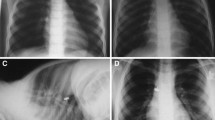Abstract
Foreign body airway is a common cause of morbidity and mortality in children. Virtual bronchoscopy is a new investigative technique useful in locating non radiopaque FB missed on plain radiography. The aim of the study was to study the clinical profile of patients with suspected foreign body aspiration and to evaluate the changing trends in the diagnosis and quicker management of foreign body aspiration as a way of virtual bronchoscopy. This was a retrospective and prospective cross sectional study conducted in the Department of Otorhinolaryngology M.G.M.M.C. and M.Y. Hospital Indore for a period of 10 years. The medical records of patients with foreign body aspiration, from August 2006 to September 2016 were reviewed. Data was collected regarding their clinical presentation, examination and chest X-ray, virtual bronchoscopy, rigid bronchoscopy findings. Patients with suspected foreign body aspiration were subjected to virtual bronchoscopy and rigid bronchoscopy was performed. The techniques and methods to extract different types of foreign bodies has been elaborated in this study. In the 150 subjects, we observed mean age group of presentation was 2.1 years, male is to female ratio was 4.1, 70% of the cases came from the rural areas, 86% were vegetative foreign bodies, and remaining non vegetative were aspirated mostly during the winter season. Betel nut was the most common aspirated foreign body 0.63% had a positive history of foreign body aspiration, where as 37% had a negative history. Right main bronchus was the most common site of lodgement. Breathlessness and reduced air entry were the most common symptoms and signs. We also observed, that chest radiograph were normal in as many as 40% cases. Hence negative chest radiographs does not rule out FB. In 150 patients with foreign body aspiration, which was detected by virtual bronchoscopy, 148 patients were diagnosed to have foreign body on rigid bronchoscopy. This amounts to a positive predictive value of 97.3% which was similar to the positive predictive value of rigid bronchoscopy which was 99%. Virtual bronchoscopy is the only imaging modality which gives 99.9% reassurance about the presence or absence of a foreign body, because of its high sensitivity and specificity, hence proves to be a life saving tool.






Similar content being viewed by others
References
Fdkowski CW, Zheng H, Firth PG (2010) The anaesthetic considerations of tracheobronchial foreign bodies in children: a literature review of 12979 cases. Anesth Analg 111(4):1016–1025
Reilly JS, Cook SP, Stool D et al (1996) Prevention and management of aerodigestive foreign body injuries in childhood. Pediatr Clin N Am 43:1403–1411
Bhatt KV, Hegde JS (2010) Evaluation of CT virtual bronchoscopy in paediatric tracheo-bronchial foreign body aspiration. J Laryngol Otol 124:875–879
Seghal A, Singh V, Chandra J, Mathur N (2002) Foreign Body Aspiration. Indian J Pediatr 39:1006–1010
Cuk V, Belina S, Fure R, Buković D, Lovrić D, Seso I (2007) Virtual bronchoscopy and 3D spiral CT reconstructions in the management of patient with bronchial cancer–our experience with Syngo 3D postprocessing software. Coll Antropol 31(1):315–320
Shlizerman L, Ashkenazi D, Mazzawi S et al (2006) Foreign body aspiration in children: ten-years experience at the Ha’Emek Medical Center. Harefuah 145:569–571
Williams A, George C, Atul PS, Sam S, Shukla S (2014) An audit of morbidity and mortality associated with foreign body aspiration in children from a tertiary level hospital in Northern India. Afr J Paediatr Surg 11(4):287–292
Shubha AM, Das K (2009) Tracheobronchial foreign bodies in infants. Int J Pediatr Otorhinolaryngol 73(10):1385–1389
Hassan MA, Youssef TA, El-Gharib M (2009) Role of virtual bronchoscopy in foreign body inhalation in children. Egypt J Otorhinolaryngol 29(4):249–253
Behera G, Tripathy N, Maru YK, Mundra RK, Gupta Y, Lodha M (2014) Role of virtual bronchoscopy in children with a vegetable foreign body in the tracheobronchial tree. J Laryngol Otol 128:1078–1084
Shepherd RW, Beamis JF (2006) Understanding the basics of rigid bronchoscopy. J Respir Dis 27(3):100–113
Author information
Authors and Affiliations
Corresponding author
Ethics declarations
Conflict of interest
All authors declare that they have no conflict of interest.
Ethical Approval
This study has been Granted ethical clearance.
Informed Consent
This study has been performed after taking high risk consent for performing rigid bronchoscopy from the patients parents also permission to use the data for research work.
Rights and permissions
About this article
Cite this article
Ullal, A., Mundra, R.K., Gupta, Y. et al. Virtual Bronchoscopy: Highly Sensitive Time and Life Saving Investigation in the Diagnosis of Foreign Body Aspiration—Our Experience. Indian J Otolaryngol Head Neck Surg 71 (Suppl 1), 378–383 (2019). https://doi.org/10.1007/s12070-018-1319-2
Received:
Accepted:
Published:
Issue Date:
DOI: https://doi.org/10.1007/s12070-018-1319-2




